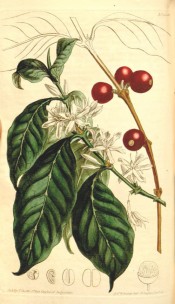Coffea arabica L.
Frost-tender evergreen shrub with elliptic leaves, to 10cm long, and fragrant white flowers in late summer, followed by reddish berries, containing 2 large seeds, the coffee beans of commerce. To 7m. [RHSD, Hortus, Don].
Horticultural & Botanical History
‘Coffee has been imported into every part of Europe, and used as a favourite beverage, long before it was known of what plant it was a product. Prosper Alpinus had seen the Coffee-tree, without fructification, in some gardens in Egypt; but the first intelligent botanical account was published by Ant. de Jussieu, In the memoirs of the Academy of Sciences in Paris in 1713. It was introduced to Europe by means of Witsen, a Burgomaster of Amsterdam and Chairman of the Dutch East-Indian company, who gave directions to the governor of Batavia to procure seeds from Mocha in Arabia Felix. These being sown in the island of Java, several plants were produced, and one was transmitted to Witsen about the year 1690, who presented it to the botanic garden of Amsterdam, of which he had been the founder. From the progeny of this plant, not only the principal botanic gardens in Europe, but also the West-India Islands, were supplied with this interesting tree. Within six years after its introduction into Holland, it appears to have been cultivated by Bishop Compton at Fulham.
Much has been written upon the effects of Coffee on the constitution, which by some are considered as highly salutary, and by others as very injurious. There is no possibility of reconciling accounts so contrary; but doubtless the effects are various upon different persons. One source of difference has not been sufficiently attended to, which is the mode of preparing and taking it; excessive roasting for instance must change its qualities altogether, and reduce it to the nature of charcoal; and what, as a grateful aromatic bitter, may, when taken pure, promote digestion, shall become altogether inimical thereto by being mixed with sugar and cream. If we expect to experience effects similar to what it produces upon the Arabs and Turks, we ought to follow their example, to use it as soon as roasted, and without admixture. Flowers with us in August and September. Propagated by the berries, which must be sown soon after they are gathered, or they will not vegetate. Being native of Arabia Felix, within the tropics, requires to be kept in the Stove, but should be allowed a free circulation of air, or the leaves become damp and covered with insects, which render the plant unsightly, and if not remedied will infalliby destroy it. Communicated by Messrs. Loddiges and Sons.’ [BM t.1303/1810].
History at Camden Park
Listed only in the 1857 catalogue [T.333/1857]. Probably introduced by Macarthur to test its potential as a crop at Camden but it is unlikely to have thrived in the gardens.
Notes
Published Feb 19, 2009 - 09:30 AM | Last updated Jul 31, 2010 - 02:55 PM
| Family | Rubiaceae |
|---|---|
| Category | |
| Region of origin | Arabia |
| Synonyms | |
| Common Name | Coffee bush |
| Name in the Camden Park Record | Coffea arabica |
| Confidence level | high |
